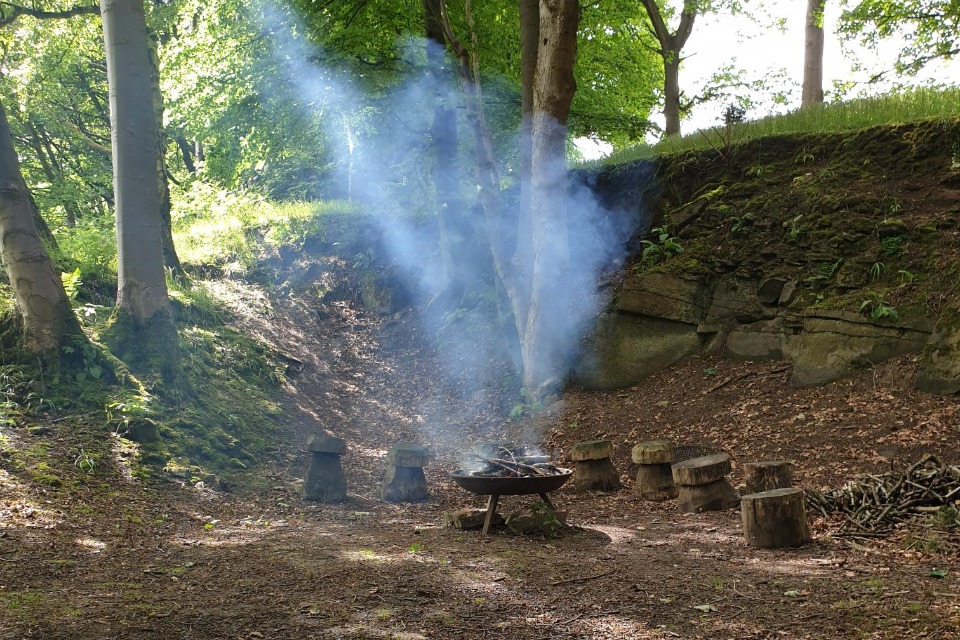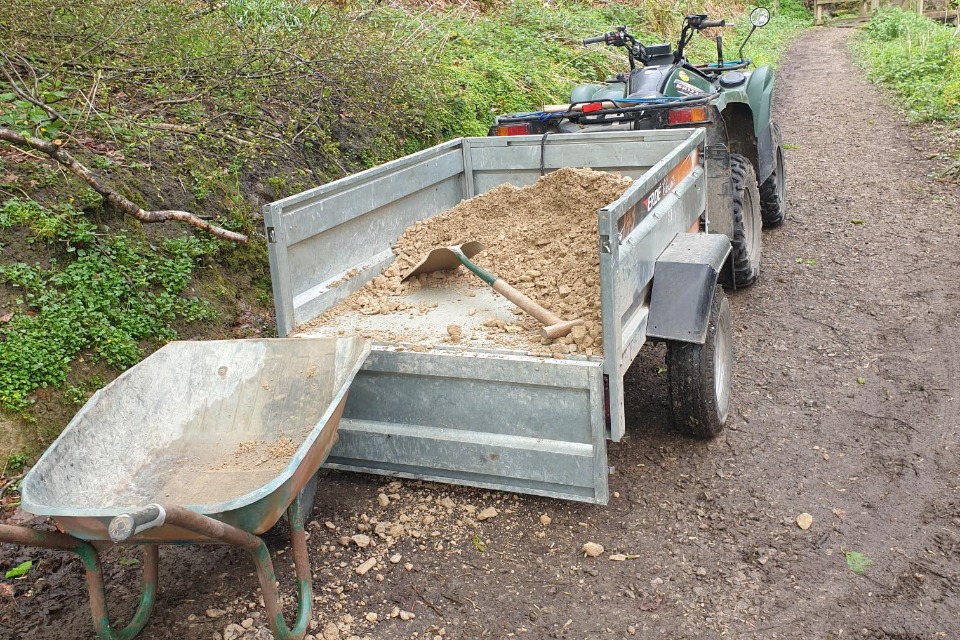Woodland restoration at Whitewoods offers a natural health service to the community
A case study on woodland restoration, and the benefits of opening woodland to the local community.
Key facts
- site: Whitewoods, Bewerley
- woodland ownership: privately owned
- type of woodland: ancient semi-natural woodland
- size: 6 hectares
- main objective: to restore the woodland
- secondary objectives: to use the woodland as a natural health service and for the woodland to pay for itself

A view of Fishpond Wood featuring a variety of tree species surrounding a tranquil large pond. Copyright Whitewoods Wellbeing Ltd.
Managing a woodland for amenity and income
Former NHS clinical director Peter and former teacher Michelle bought Whitewoods in Nidderdale 11 years ago. They wanted a woodland for amenity use that would also pay its own way.
‘Amenity woodland’ is a forested area managed primarily for public enjoyment, recreation, and aesthetic value, rather than for commercial timber production.
In the first year, they commissioned a woodland management plan from a forestry expert. This allowed them to fell some sycamore trees, and plant hazel, willow and wild cherry trees. They now use two-thirds of the woodland for amenity and one-third is left solely for nature.
Since buying the woodland they’ve collaborated with local groups, inviting schools in for free but charging groups who can afford a fee, while some voluntary groups make a donation. They sell logs locally, which has enabled them to introduce themselves to their neighbours. They make some rustic wooden furniture and, for a small fee, let people scatter ashes (away from watercourses) and plant and dedicate a tree to the memory of a loved one.
A range of volunteer groups and casual visitors enjoy helping to manage the woodland, which has terrain and ponds that limit what machinery can be used. The groups bring ideas and expertise, and the woodland gives back to the community, providing adventure play and a place to build new skills and make new friendships.
Peter Brambleby, Owner, Whitewoods said:
If we hadn’t opened our wood to people, we wouldn’t have been nearly as far advanced as we are with its regeneration for wildlife.
Community and wellbeing benefits
Having worked in healthcare and education respectively, Peter and Michelle Brambleby knew the value of natural spaces for health, wellbeing and therapy.
A nearby council-run outdoor centre had used the woodland before the current owners bought it and have permission to bring groups to the woods for free. They have created an orienteering trail and run midnight walks. A local secondary school also freely use the woods for impromptu lessons such as maths classes.
A group of army veterans, some of whom have post-traumatic stress disorder visit the woodland for a chainsaw training course and to gain qualifications. Having access to the woodland has given them the opportunity to gain new skills and pursue further employment in arboriculture. The veterans found the woodland to be a healing environment, and felt they could talk more easily side by side.
A charity for people with learning difficulties and mental health conditions visit the site. They have made benches, cleared brash, planted trees and made dead hedges: a barrier made from cut branches.
Peter Brambleby, Owner, Whitewoods said:
Our model is a natural health service, using the woodland as a therapeutic place and classroom, therapist and teacher. Facilitate the process and let the wood do the magic.
Overcoming challenges
If groups, particularly children, visit the woodland in bad weather, there needs to be shelter provided. Gaining planning permission for a shelter within a National Landscape was challenging and needed a planning consultant to agree what was needed with the planning officer.

Whitewoods firepit area with wooden stump seating. Copyright Whitewoods Wellbeing Ltd.
To make sure everyone can enjoy the woodland safely, the owners wrote agreements for some groups. For example, a written memorandum of understanding is in place with the outdoor centre to allow managed access to the woods without a fee.
Having groups visit means that the right risk assessments and insurance need to be in place, particularly if this includes school groups, or vulnerable children and adults. As a former teacher, Michelle has experience in carrying out the necessary risk assessments. Peter and Michelle wrote risk mitigation strategies and have an accident and incident book in place. However, the owners’ approach is that children learn from being allowed to take sensible and managed risks, such as tending campfires, being near water or heights, and using tools – with an appropriate level of adult supervision.
The owners found the biggest cost is their annual liability insurance, but they have now found an insurer that is used to working with organisations that provide activities such as bushcraft courses, so they have a good understanding of what’s needed.
A flourishing woodland for people and wildlife
The woodland has permissive paths and one public footpath that the public can enjoy. Now that visitors can see the woodland is being managed, the owners have noticed how much more visitors care for it. The public can walk through the woods, and this acts as a natural deterrent for antisocial behaviour. When the owners first bought the wood they had to remove large amounts of waste, but now local people see the woodland as theirs to look after and there is no more waste being dumped.

Stones are distributed to woodland tracks to improve woodland access. Copyright Whitewoods Wellbeing Ltd.
Regenerating the woodland with help from visitors who have cleared brash and planted new trees has made the wood more biodiverse and birdlife is once again flourishing. The owners have also learnt more about low-cost biosecurity measures from visitors, as a group of visiting National Trust volunteers advised that visitors should wash their boots to mitigate the spread of tree pests and diseases.
The owners installed dog waste and litter bins, which are emptied every 6 weeks as general waste, eliminating any dog fouling issues. There were also issues with dogs not being kept on leads, which can disturb wildlife and frighten vulnerable children. However, these challenges were overcome by displaying politely worded notices carved into wood. The woodland owners also recruited local dog walkers to police the woodland to ensure dogs were kept on leads at all times.
Signs showing visitors where to park, and leaving polite notices to highlight to when people have parked in the wrong place, has improved overall safety and access to the woodland.
The woodland now boasts its own artist-in-residence, James Owen Thomas. James has autism and finds fulfilment in making pictures of trees and natural subjects from recycled materials. He is an artist specialising in collage and has returned to the woodland to run inspiring forest collage workshops.
Working closely with visiting schools, the owners have been able to move away from rigid activity and learning plans, to more self-directed adventure play. This gives children the opportunity to practice empathy, problem solving and cooperation. They’ve seen the positive impact on neurodiverse children and young visitors when learning in a woodland setting, especially when participating in activities that suit their individual needs.
Peter Brambleby, Owner, Whitewoods said:
People need nature, but nature needs people. The best therapy is purposeful activity with other people. Help lay a path, help make a bench. The underlying messages are that it’s definitely worth sharing woodland spaces, there is a richer return on investment than just the finances, and you don’t just grow trees and promote wildlife, you grow people and communities.
Top tips for providing visitor amenities
Provide essential amenities for visiting groups, such as:
- shelter and toilets: the owners installed composting toilets as there is no mains water and no borehole on site
- clean water: the owners bring in drinking water as there is none on site, and rainwater is captured on site for hand washing
- safe storage for tools and equipment: you may need consent for this facility
- clearly marked permissive paths and waste bins: this helps guide people to areas they are welcome and reduce littering, making responsible choices easy choices
More resources on public access in woodland
Read about the benefits of providing public access to woodland, and what funding is available on Managing public access in your woodland.
Learn more about public rights of way: landowner responsibilities.